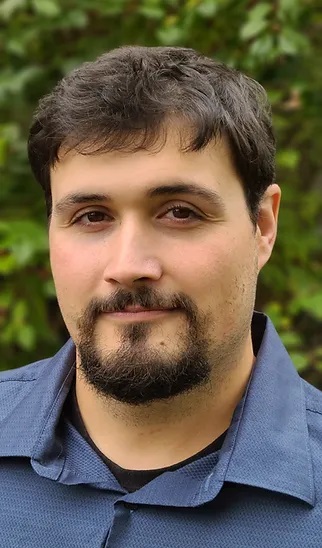
Brain-on-a-chip tech powers neuroscience research
A tiny device that fits into the palm of your hand may hold the key to recreating one of the body’s most intricate systems: the brain and its vascular network.

Brian O’Grady, a postdoctoral fellow at Vanderbilt University and an American Society for Biochemistry and Molecular Biology Maximizing Opportunities for Scientific and Academic Independent Careers, or MOSAIC, scholar, has developed a method to isolate blood vessels from postmortem human brain tissue and cultivate them in a hydrogel that mimics the brain’s natural environment. He calls this system a brain-on-a-chip. It’s about the size of a house key.
While pursuing his master’s degree in biology, O’Grady found himself craving more hands-on, practical work. He loved getting his hands dirty and repairing things, like his perpetually broken prized possession: a 1971 Corvette. So, he built a career in materials science and biomedical engineering.
“I really wanted to engineer solutions or create engineering components to solve important biological questions," O’Grady said.
But, what to build? He set his sights on creating a model system to test drugs for brain cancers such as glioblastoma.
Because the human brain is so complex, “clinical trials often fail,” O’Grady said. “They have over a 95% failure rate. It's just incredibly bad, so we need better models."
Historically, artificially recreating the extracellular matrix of the brain has stumped scientists because it contains dozens of components including glycosaminoglycans, proteoglycans, tenascins, collagens and more.
O’Grady’s setup overcomes this challenge using an essential molecule, N-cadherin peptide. This peptide bolsters the extracellular matrix of the brain-on-a-chip system and promotes cell survival and maturation.
“We used the peptide to trick neural cells into thinking that they're surrounded by other neural cells,” O’Grady said. “Normally cells in the brain are really, really tight and touching each other, so there's sort of a handshake between the cells. So, we took the peptide and put it on the backbone of the hydrogel, and the neural cells think they’re surrounded by other neural cells despite being surrounded by hydrogel.”
O’Grady’s brain-on-a-chip offers an unprecedented way to simulate the human brain’s vascular structure that could revolutionize drug testing and disease research, paving the way for advances in neuroscience and biotechnology.
He said he hopes this model system will improve the success rates of clinical trials by enabling preclinical testing in an environment that better recapitulates the elusive properties of the blood–brain barrier.
(Farah Aziz Annesha contributed to this article.)
Enjoy reading ASBMB Today?
Become a member to receive the print edition four times a year and the digital edition monthly.
Learn moreGet the latest from ASBMB Today
Enter your email address, and we’ll send you a weekly email with recent articles, interviews and more.
Latest in People
People highlights or most popular articles

Mydy named Purdue assistant professor
Her lab will focus on protein structure and function, enzyme mechanisms and plant natural product biosynthesis, working to characterize and engineer plant natural products for therapeutic and agricultural applications.

In memoriam: Michael J. Chamberlin
He discovered RNA polymerase and was an ASBMB member for nearly 60 years.

Building the blueprint to block HIV
Wesley Sundquist will present his work on the HIV capsid and revolutionary drug, Lenacapavir, at the ASBMB Annual Meeting, March 7–10, in Maryland.

In memoriam: Alan G. Goodridge
He made pioneering discoveries on lipid metabolism and was an ASBMB member since 1971.

Alrubaye wins research and teaching awards
He was honored at the NACTA 2025 conference for the Educator Award and at the U of A State and National Awards reception for the Faculty Gold Medal.

Designing life’s building blocks with AI
Tanja Kortemme, a professor at the University of California, San Francisco, will discuss her research using computational biology to engineer proteins at the 2026 ASBMB Annual Meeting.

